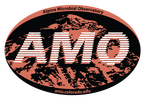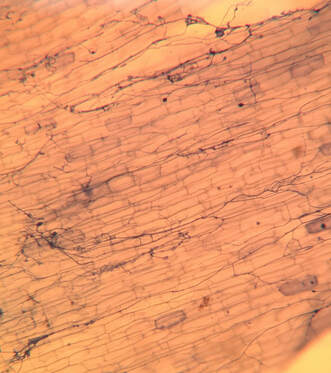|
by Cliff Bueno de Mesquita We have started another round of microscopy here in the AMO. We are collaborating with the Suding Lab on understanding how nitrogen deposition and plant species interactions affect microbial communities. One aspect of the work, as in some of our other projects, is to quantify how much of the plant roots contain certain fungi. I have previously written about both arbuscular mycorrhizal fungi and dark septate endophytes, which are two groups of fungi that inhabit plant roots, but there is another – fine root endophytes – that I will tell you about today. Fine root endophytes (FRE) are a newly classified group of fungi that are characterized by having very fine hyphae. FRE were once considered to be arbuscular mycorrhizal fungi until further genetic work was able to distinguish them. Morphologically, they can be distinguished by their very fine hyphae, which are less the 2 µm wide – that’s 0.002 millimeters. But with the help of the microscope we can view them and identify them as FRE. They look like little fine blue lines (because we stain them with a blue dye) running all throughout the plant roots (Figure 1). Several studies have suggested that FRE can help plants uptake phosphorus, which means they may be functionally similar to arbuscular mycorrhizal fungi. FRE were once thought to be the species Glomus tenue, now reclassified as Planticonsortium tenue, but now several different morphologies have been observed and it is likely that there are several different species of fine root endophytes.
FRE are distributed globally, have been reported in 53 plant families, and have been found in all major habitat types. As we and others continue to quantify the amount of FRE in various plant species and various environments, we can learn more about the ecology of this potentially important fungal group. Additionally, more experiments are needed to learn more about the functioning of FRE. References: Orchard S, Hilton S, Bending GD, et al (2017a) Fine endophytes (Glomus tenue) are related to Mucoromycotina, not Glomeromycota. New Phytol 213:481–486. doi: 10.1111/nph.14268 Orchard S, Standish RJ, Dickie IA, et al (2017b) Fine root endophytes under scrutiny: a review of the literature on arbuscule-producing fungi recently suggested to belong to the Mucoromycotina. Mycorrhiza 27:619–638. doi: 10.1007/s00572-017-0782-z Walker C, Gollotte A, Redecker D (2018) A new genus, Planticonsortium (Mucoromycotina), and new combination (P. tenue), for the fine root endophyte, Glomus tenue (basionym Rhizophagus tenuis). Mycorrhiza 28:213–219. doi: 10.1007/s00572-017-0815-7
0 Comments
|
AuthorVarious lab members contribute to the MoM Blog Archives
October 2023
Categories |


 RSS Feed
RSS Feed
